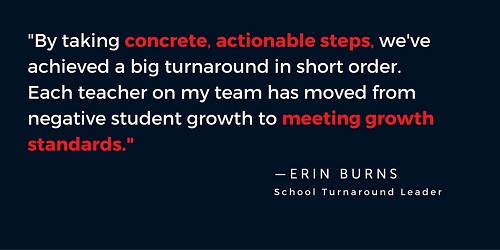Editor’s Note: I heard Erin Burns speak at an Opportunity Culture conference about her decision to return to the same struggling high school where she started her teaching career. She ended up turning around a whole team of veteran teachers by helping them to form more effective teaching habits. I asked Erin to share the recipe to her secret sauce. —Kate Walsh
My first teaching job was as a high school biology teacher in an urban, Title 1, North Carolina school serving mostly low income, minority students. I arrived at age 22 with an inextinguishable passion for the power of education to achieve social justice, excited in particular about hands-on biology lessons. However, my pineapple eating Jello enzyme demo and edible candy DNA activities were quickly shunned by my colleagues for being too cutesy and I was instructed to drill students with multiple choice worksheets instead. I left after just one year to teach at a neighboring school that embraced my more hands-on approach. There, those same “cutesy” activities led to some of the highest student growth scores in the entire school.
Five years later, with data to back up my teaching style and some leadership experience under my belt, I ventured back to that same high school—still as underperforming as ever—where my career began. This time I was to lead the school’s biology team.
By taking concrete, actionable steps, we’ve achieved a big turnaround in short order. Each teacher on my team has moved from negative student growth to meeting growth standards.

I’ve learned a lot about the habits which can stand in the way of a teacher’s success.
Here are my top five:
1) Rigid (boring) lesson structures
Many low performing schools fear any activity that doesn’t have a rigid structure. Rigidity does not always equal rigor. For example, my teachers did a lesson in which we modeled DNA & Protein Synthesis by decoding a “DNA recipe” and creating, of all things, Rice Krispie treats. Students were up around the room transcribing mRNA to gather ingredients and make their “protein” (Rice Krispie treat). Though there were slight moments of chaos because students were so excited, every student was engaged. Students would frequently reference these types of engaging lessons and activities at the end of the year, as they had made a memorable impact. Worksheets and multiple choice drills, although they may look more controlled from an outside perspective, were not frequently referenced as having a significant impact on the students’ deep understanding of the material.
2) Not being organized.
Disorganization can lead to hours of valuable time lost, duplicating the workload for teachers. Teachers in my school used to spend hours searching for last year’s flash drive, worksheet or lesson. Teachers are not always taught how to create a systematic way to organize lessons and materials.
I created a central repository (with the use of Google shared drives) for everyone to combine resources. We created a standardized lesson plan template built into a PowerPoint. Teachers could simply pull up the PowerPoint with directions for the activities, notes, etc. all at their fingertips. Now, my teachers know exactly where the aligned lessons are located and can focus on tweaking the lesson as opposed to repeatedly, frantically creating something from scratch.
Furthermore, teachers bought into this system because they had created the original shared lesson plan; as opposed to using a purchased, packaged curriculum.
3) Reactive, rather than proactive, classroom management
At my school, too many teachers previously let one disruptive student ruin the entire class period for the other 29 students eager to learn. For example, a student might have put on headphones and disruptively started singing along. This would then be typically followed by a loud five-minute spectacle between student and teacher ultimately ending with the student being removed from class. Inevitably these confrontations have ripple effects, resulting in multiple students being kicked out, wandering the hallways and missing out on even more instruction.
Instead, I encouraged teachers to take preventive measures. Before these incidents multiply, identify the few students in need of special emotional support and behavior correction (conferences, calls home or utilization of administrators). Proactively build positive relationships with those students who are behaving well.
Simply walking around the room and talking to students as individuals has an incredible impact on classroom culture. “How did you do at the game last night?” “Did you get that new job you applied for?” I would frequently model this strategy for my teachers. This can take as few as 30 seconds, but it has big payoffs.
4) Administering tests and quizzes too infrequently
It may be unpopular in this anti-testing environment to suggest more testing, not less; but it works. My team of teachers transitioned from one large test every few weeks (that wasn’t revisited until the final exam), to numerous mini tests and quizzes.
Now, with more frequent assessment, students have multiple attempts to show mastery of a concept. Students have hope after failing a test as opposed to just giving up and having to accept the F. We’ve built in opportunities for students to retest and replace poor quiz grades on large interim assessments. They always have the opportunity to work towards a higher grade and grow their knowledge of the topics covered as the semester progresses.
This change meant helping my colleagues make a shift in mindset as well as building a strongly planned assessment calendar. It’s been worth it.
5) Infeasible goals for improvement
In the same way that we built in an assessment calendar for our kids, those of us who lead teachers need to have a growth mindset for adults, reevaluating where an individual teacher is each week, quarter and semester. We are told never to label students as failures—why should we do so with teachers?
When I first started working with my team, many of my teachers simply needed a shift in outlook because they were constantly told that their students’ poor test scores were all their fault. I started by acknowledging their frustrations. Oftentimes, this simply looks like a brief venting or therapy session. Yes, it can be draining for a school leader, but it is necessary to let teachers get it off their shoulders. Let their voice be heard so they can move on.
I pushed my team to grow their students as individuals. Our goal was beyond hitting a specified proficiency number, but to simply make sure our students left our classes knowing more biology than when they entered. The proficiency numbers would increase eventually if we just focused on growing students one by one.
Allowing teachers to focus on growth instead of a seemingly impossible, looming proficiency goal allows them to stop acting out in frustration to student behavior and lack of engagement and starting focusing on their individual student growth goals. When leaders create a culture of focusing on the positive, it trickles down to teacher-student interactions.

Creating a teacher turnaround plan without observing or talking to your teachers will flop. Stop boring lessons. Stop wasting time by looking for ways to work more efficiently and collaboratively. Stop modeling or allowing negative student-teacher relationships. Stop giving students only one chance to demonstrate mastery. And stop only focusing on your failing test scores. Start creating individual turnaround plans for each of your teachers with students at the center.
About the Author
Erin Burns is in her 7th year of education. She was a North Carolina Teaching Fellow, received her Bachelors in Biology with minors in Education and Entrepreneurship from The University of North Carolina at Chapel Hill, and her Master of Education Leadership from Teachers College, Columbia University. She is currently in her second year as part of Project Lift Turnaround (a component of the OPportunity Culture), serving as a Multi Classroom Leader in her school.
More like this

National Council on Teacher Quality opposes the executive order to dismantle the Department of Education

Black History Month: Learning to read is a civil right

As seasons change, one thing remains the same: The persistent lack of diversity in the teacher workforce


